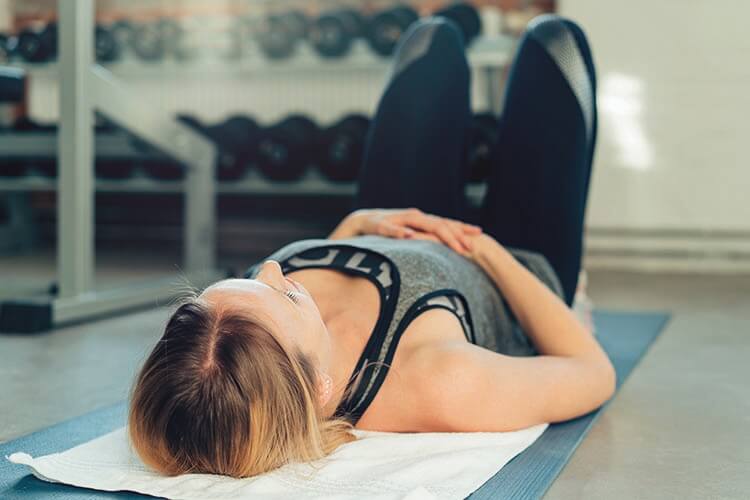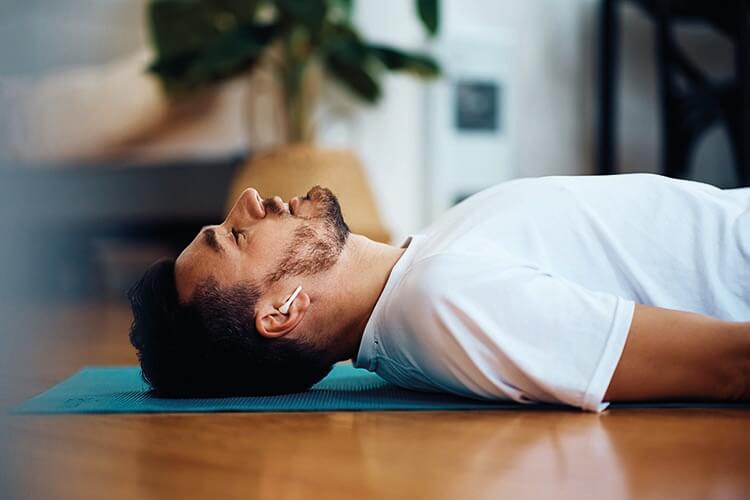
Emma Farrell has taught her breathing optimisation courses to divers, freedivers and Olympic athletes for a number of years – here are some of her top tips and two five-minute exercises
Breathing is so natural and instinctive that we rarely pay much attention to it, but this simple physical process impacts every area of our lives – from facial development when we are young, to sleep, energy and concentration levels as we get older.
As divers, breathing determines not only the length of the dive but also the quality. The more effective, controlled and relaxed is your breathing, the safer and more enjoyable is the dive. And learning to optimise your breathing will also improve your physical and mental health out of the water.
So, how do you know if you are maximising your breathing potential for diving? Could you have a breathing dysfunction and not realise? What is breathing dysfunction, and how does this affect scuba diving?
When breathing efficiently, your diaphragm performs up to 80 per cent of the work. This is the most energy-efficient and relaxing way to breathe. However, many people do not breathe the way we were designed to, or even recognise that they have a problem.
The common symptoms of breathing dysfunction include breathlessness; mouth breathing; snoring; short, shallow breaths; raising the shoulders and top of the chest when breathing; persistent coughing; yawning – even when not tired; regular sighing; inability to take a deep breath; dizziness; pins and needles; poor concentration, and fatigue or lethargy.
How does inefficient or dysfunctional breathing affect your performance as a scuba diver?
As a scuba diver, your breathing (and oxygen consumption) can be affected by a number of factors. Here are some you should be aware of:
Kit: The kit you wear (and the way you wear it) can affect your ability to breathe correctly. This includes your weights, belt, mask, regulator and suit.
Diet: Your diet (general and before a dive) can impact your general comfort, safety and ability to breathe correctly when diving.
Mental state: Stress, anxiety or over-excitement can impact your ability to relax enough to focus your breathing to dive efficiently. Energy: Are you wasting energy by exerting yourself more than necessary?
Tiredness: Diving when tired is a surefire way to breathe more rapidly, as your body craves oxygen.
Lifestyle: If you are a smoker, or generally unfit, your lungs must work harder to achieve the same experience as a non-smoker/healthier person. This additional effort will draw on extra oxygen when diving.
Adopting and practising breathing optimisation exercises can help significantly and has the added benefit of improving your general health and wellbeing.
Conditions: Dive conditions can impact your performance and air consumption. However, breathing correctly will, whatever the conditions, extend your dive
and improve your overall dive experience. This can also improve safety for both you and your buddy.
Experience: If bad habits set in, they can be hard to change. However, if you practise breathing techniques regularly, it will soon become an instinctive way to
breathe when diving.
Emergencies: As with any sport, there are risks. Learning to breathe properly, calmly, and with control and focus, can assist significantly should there be a medical emergency or any type of equipment failure underwater.

How should we breathe when scuba diving?
I have taught breathing optimisation courses to scuba divers and diving clubs for many years, and there is always a common factor among the divers who are using excess air – it is the way that they breathe.
The most frequent issue is breathing too fast and/or taking in too much volume. Not only does this affect buoyancy, but it also becomes a vicious cycle of needing more air because the diver is breathing more rapidly – which often leads to hyperventilation.
When we are inhaling correctly, the diaphragm flattens, drawing air into our lungs. On exhalation, it relaxes back up into the chest cavity. The diaphragm should be responsible for around 75 to 80 per cent of our breathing, helped by the intercostal muscles between the ribs.
Scuba divers can significantly reduce the amount of air they use during diving. The main focus should be on slowing your breathing and relaxing your body. By learning to breathe deeply you will calm your mind and body, leading to your dives being longer and infinitely more enjoyable.
The most efficient way to breathe for scuba diving is as follows:
- Breathe deep into the abdomen –‘belly breathing’
- Breaths should be relaxed, gentle and slow
- Be calm, controlled and conscious of your breathing
- Use a passive inhalation and passive exhalation
- Pause slightly at the end of the exhalation
- Extend the exhalation
- Aim for six to eight breaths a minute
- No skip-breathing
- Don’t over-breathe. The more you over-breathe, the more oxygen you guzzle
What are the added benefits of learning to breathe efficiently?
The techniques you learn when practising breathing optimisation also carry across to your everyday world. Many of my students use their breathing techniques and skills to help with anxiety, stress, mental health conditions, performance at work, anger management, medical conditions, relaxation, sleep disorders, illness recovery and more.
I have even seen students completely overhaul their lifestyle as they gain more energy, enthusiasm and motivation during courses
So how can you start improving your breathing? The most important first step is awareness and control.
TWO EXERCISES YOU CAN TRY AT HOME OR WORK
The Two-Part Breath
This is two-thirds of a full breath in and out. It’s best to practise this first before a complete inhalation (the three-part breath), as you want to make sure you remain relaxed so you don’t do the work with your upper chest and shoulders.
Either lie down (your legs can be flat, or bent with feet on the floor or bed, and your knees together), or sit so that the spine is comfortably straight. You can sit on the floor, but most people will be more comfortable sitting on the edge of a chair, with the hips higher than the knees.
Place one hand on the ribs, the other hand over the tummy, palm down, just below the belly button.

Breathe gently in and out through the nose. This should be a passive inhalation and a passive exhalation – also known as ‘tidal volume’ breathing. It’s about twenty per cent of your total lung capacity and the kind of breathing you do when you’re completely at rest.
Close your eyes and check that the muscles of the face are relaxed, the shoulders are relaxed, and the rib cage is not moving. There should be a slight rise
of your belly as you inhale and deflation as you exhale. Please note that as you become more relaxed, it’s normal to have a slight pause at the end of the exhalation.
Once you have established a comfortable and relaxed rhythm, start to increase the amount of air you breathe in and out without moving the ribs, upper
chest or shoulders. You’ll find that the tummy expands more on the inhale, and on the exhale you want to contract your abdominal muscles to squeeze out
as much air as possible. Double-check that all the muscles of your face are still relaxed, as is your lower jaw.
Now, move your hands so the palms are touching the sides of the chest. Focus your breathing here, trying to expand the ribs as much as you can on the inhalation, and contract them as much as you can on the exhalation. Make sure each breath is slow, controlled and relaxed.
Once you feel you have a comfortable rhythm, put the two parts together. First, expand the belly and fill the lower portion of the lungs as much as you can; then
expand the ribs. Please note that when you inflate the chest, it is normal for your tummy to deflate slightly.
Double-check at all times that your shoulders remain relaxed and that you are not light-headed or dizzy. If you experience dizziness, you have accidentally hyperventilated and need to slow down your breathing rate.
This exercise should take about five minutes.
Battlement Breathing
I call this exercise ‘Battlement Breathing’ because it is in the shape of battlements. You may have come across this exercise before as ‘box’ breathing. It is incredibly relaxing and helps with breath awareness and control.
Either lie down (your legs can be flat, or bent with the feet on the floor or bed and your knees together), or sit so the spine is straight. You can sit on the floor, but most people will be more comfortable sitting on the edge of a chair, with the hips higher than the knees. Your hands can be at rest by your sides, or on your body.

Your breathing during this exercise should be soft, gentle, small and relaxed – tidal volume breathing (as above) or very slightly more. You should not become dizzy at any point. Try to ensure your breath is completely silent.
Inhale and exhale through the nose at all times, periodically checking that your facial muscles are completely relaxed, your lower jaw is relaxed, and your
tongue is heavy in your mouth.
Inhale for a count of four, hold your breath for a count of four, exhale for a count of four, and then hold your breath for a count of four. Remember, this is a tidal volume breath, not a full breath. In terms of the speed of the count, match the count to your heartbeat. Your shoulders and ribs should not move.
Once you have a relaxed and comfortable rhythm, try increasing the count to, six in, six hold, six out and six hold, but only if it is comfortable to do so.
This exercise should take about five minutes to complete. When you finish, allow yourself a minute or so of soft, gentle abdominal breathing.
Optimising your breathing won’t just improve your diving and air consumption, it will benefit all areas of your life. By learning how to breathe more efficiently and maximising your lung function, you can positively impact your sleep, stress and general health, and feel more confident both above and below the surface of the water!
Emma is one of the world’s leading free diving instructors She has worked with UK Sport, developing programmes for Olympic and Paralympic cyclists, swimmers and rowers to optimise their performance. She has created two videos of her teaching these exercises: www.breathingoptimisation.com


